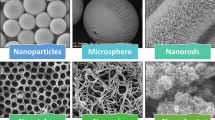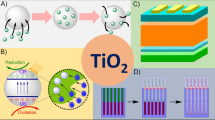Abstract
The photochromism of poly methyl methacrylate–TiO2 composites have been investigated in this research. Amorphous titanium oxide was synthesized by sol–gel using titanium isopropoxide. The titanium solution was mixed with a dissolved polymer. The composite shows photo-response under UV radiation by changing, generally, to a dark brown tonality. This effect was reversible in different time ranges according to the intensity and exposure time. The mechanism for this photochromic change was proposed as a reduction of TiOOH domains to Ti3+ and not directly from amorphous TiO2, which provide electron-hole pairs after absorbing UV. The backscattered electrons image shows the clusters or domains of titanium compounds as white dots, ranging from 0.1 to 1 μm. The electron spin resonance spectroscopy signals indicated a titanium valence change from Ti(IV) to Ti(III). The X-ray photoelectron spectroscopy peaks positions for Ti 2p1/2 and Ti 2p3/2 were assigned as Ti4+. The values were obtained for Ti 2p3/2 and the identified species were Ti4+ and Ti3+, that correspond to TiO2, Ti2O3, and Ti(OOH). Few and small crystalline domains were identified by Transmission Electron Microscope as orthorhombic TiO2.’
Graphical Abstract








Similar content being viewed by others
References
Neupane MP, Park IS, Bae TS, Yi HK, Watari F, Lee MH (2012) Biocompatibility of TiO2 nanotubes fabricated on Ti using different surfactant additives in electrolyte. Mater Chem Phys 134:536–541
Tomar LJ, Chakrabarty BS (2013) Synthesis, structural and optical properties of TiO2 -ZrO2 nanocomposite by hydrothermal method. Adv Mater Lett 4:64–67
Paramasivam I, Macak JM, Ghicov A, Schmuki P (2007) Enhanced photochromism of Ag loaded self-organized TiO2 nanotube layers. Chem Phys Lett 445:233–237
Miao L, Ina Y, Tanemura S, Jiang T, Tanemura M, Kaneko K, Toh S, Mori Y (2007) Fabrication and photochromic study of titanate nanotubes loaded with silver nanoparticles. Surf Sci 601:2792–2799
Fatma H, El-Batal (2009) UV-visible, infrared, Raman and ESR spectra of gamma-irradiated TiO2-doped soda lime phosphate glasses. Indian J Pure Appl Phys 47:631–642
Zhang J, Jin Z, Feng C, Yu L, Zhang J, Zhang Z (2011) ESR study on the visible photocatalytic mechanism of nitrogen-doped novel TiO2. J Solid State Chem 184:3066–3073
Bach LG, Islam MR, Gal YS, Lim KT (2012) Synthesis and characterization of TiO2/Poly(methyl methacrylate) nanocomposites via surface thiol-lactam initiated radical polymerization. J Nanosci Nanotechnol 12:5976–59
Gonçalves RH, Schreiner WH, Leite ER (2010) Synthesis of TiO2 nanocrystals with a high affinity for amine organic compounds. Langmuir 26:11657–11662
Singho ND, Johan MR (2012) Complex impedance spectroscopy study of silica nanoparticles via sol-gel method. Int J Electrochem Sci 7:5604–5615
Zupanič F (2010) Extracting electron backscattering coefficients from backscattered electron micrographs. Mater Charact 61:1335–1341
Stefanov P, Shipochka M, Stefchev P, Raicheva Z, Lazarova V, Spassov L (2008) XPS characterization of TiO2 layers deposited on quartz plates. J Phys Conf Ser 100:012039
Antony RP, Mathews T, Ajikumar PK, Krishna DN, Dash S, Tyagi AK (2012) Electrochemically synthesized visible light absorbing vertically aligned N-doped TiO2 nanotube array films. Mater Res Bull 47:4491–4497
Wang Z, Helmersson U, Käll P-O (2002) Optical properties of anatase TiO2 thin films prepared by aqueous sol–gel process at low temperature. Thin Solid Films 405:50–54
Gao Y, Masuda Y, Peng Z, Yonezawa T, Koumoto K (2003) Room temperature deposition of a TiO2 thin film from aqueous peroxotitanate solution. J Mater Chem 13:608–613
Zheng M-P, Gu M-Y, Jin Y-P, Jin G-L (2001) Photochromism of titanium oxide sol and gel. J Mater Sci Lett 20:485–486
Endut Z, Hamdi M, Basirun WJ (2013) Supercapacitance of bamboo-type anodic titania nanotube arrays. Surf Coatings Technol 215:75–78
Khan MM, Ansari SA, Pradhan D, Ansari MO, Han DH, Lee J, Cho MH (2014) Band gap engineered TiO2 nanoparticles for visible light induced photoelectrochemical and photocatalytic studies. J Mater Chem A 2:637–644
Shi N, Li XH, Fan TX, Zhou H, Ding J, Zhang D, Zhu H (2011) Biogenic N-I-codoped TiO2 photocatalyst derived from kelp for efficient dye degradation. Energy Environ Sci 4:172–180
Jensen H, Soloviev A, Li Z, Søgaard EG (2005) XPS and FTIR investigation of the surface properties of different prepared titania nano-powders. Appl Surf Sci 246:239–249
Acknowledgements
Thanks to Dr. Carlos Angeles (IMP) for TEM Images, to Rosendo López (UAM-I) for UV-Vis Spectra and to Dr. Alejandro Solano (UNAM) for ESR spectra. The authors gratefully acknowledge the financial support from the Mexican Council for Science and Technology (CONACYT, Grant CB-2009-01 133157). In addition, the authors acknowledges CONACYT for the graduate fellowships. Special thanks to the Centro de Nanociencias y Micro y Nanotecnologías (CNMN)-IPN for their help in doing the XPS, ellipsometry and SEM analyses shown. The authors gratefully acknowledge Eric Albert Huston for his valuable comments about improving this written work.
Author information
Authors and Affiliations
Corresponding author
Ethics declarations
Conflict of interest
The authors declare no competing financial interests.
Rights and permissions
About this article
Cite this article
Tandy, L.M.F., Bueno, J.J.P., Vong, Y.M. et al. Reversible photochromic effect in the TiO2—polymer hybrid system. J Sol-Gel Sci Technol 82, 51–58 (2017). https://doi.org/10.1007/s10971-016-4292-9
Received:
Accepted:
Published:
Issue Date:
DOI: https://doi.org/10.1007/s10971-016-4292-9




